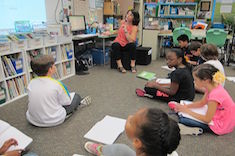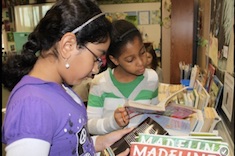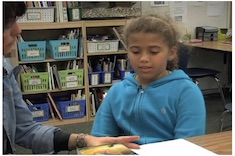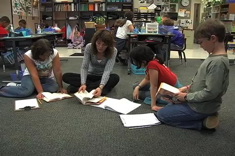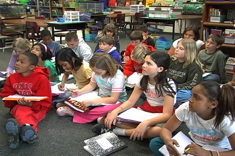My yearlong exploration of Visible Thinking Routines began with a vision for my students and their learning lives. I wanted students to leave fourth grade prepared to think about and freely discuss the characters who make up both their reading lives and their real-world lives. By growing students’ thinking skills through flexible routines, I could achieve this goal. The ability to form ideas and support thinking with evidence would carry students far beyond the classroom.
To benefit a range of learners, I decided to introduce different Visible Thinking Routines during read aloud. All students, no matter their reading levels, could participate and thrive within our book community. The novels selected for the year shared a host of well-developed characters facing hard truths. Since fourth graders are expected to identify character traits with supporting evidence, a character-driven routine called Color-Symbol-Image, or CSI, seemed a logical place to begin.
Early Fall
Before capitalizing on the Color-Symbol-Image routine with longer novels, I introduced it with picture books. I began by modeling my own thinking and then gradually brought students into the process using a collection from Kevin Henkes. His books provide accessible stories with characters of surprising depth. I started with an old favorite:
|
Day |
Book |
Lesson |
|
1
|
|
Owen is pressured by many adults in his life to give up his security blanket, but he has other plans in mind. After sharing Owen, I introduced and explained the Color-Symbol-Image routine; I demonstrated how it helps me think and share my perceptions of Owen.
|
Here is a digital chart that I created, modeling my thinking aloud for students.
|
Color |
Symbol |
Image |
|
When I think about Owen |
When I think about Owen |
When I think about Owen |
|
I think about the color gray. |
I think about a symbol of a plus and minus sign. |
I think about an image of a person reflected in a bubble. |
|
Because he wants to be invisible like a shadow to the nosy grown-ups who want him to give up his security blanket. |
Because Owen wants to keep something special, yet others want to take his blanket away. |
Because the grown-ups are not thinking about or reflecting on what Owen needs. They are thinking about what they need. |
Over the next few days, I modeled and encouraged students to join me with the CSI routine as we enjoyed and discussed Henkes’s other books.
|
Day |
Book |
Lesson |
|
2 |
|
We read Chrysanthemum, and with discussion, the group helped me create a CSI chart; we thought of a color, symbol, and image associated with Chrysanthemum. |
|
3 |
|
On Day 3 we read A Weekend with Wendell. Students completed a CSI chart, copying the group’s ideas and learning to record on their own chart. |
|
4&5 |
|
On Days 4 and 5, students were challenged to try the CSI routine on their own or with a partner. Discussions were followed by completing their CSI charts. Charts were then shared with peers to expand thinking opportunities through focused book conversations.
|
Color-Symbol-Image is a routine that encourages students to study book characters just like they would make close observations of best friends, family members, or frustrating antagonists in their own lives. Characters and real people have outer lives we witness and inner lives we try to understand. Humans make choices. They create their own solutions and mistakes. What makes life joyous, interesting, and frustrating is that we are surrounded by characters and people who are forever making us wonder.
We spent our year exploring more than just the CSI routine; students learned to think about story characters and real people so they could discover the clues, keys, and paths to what it means to be human.



